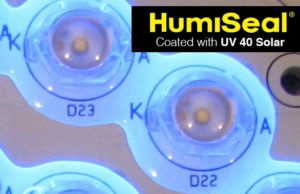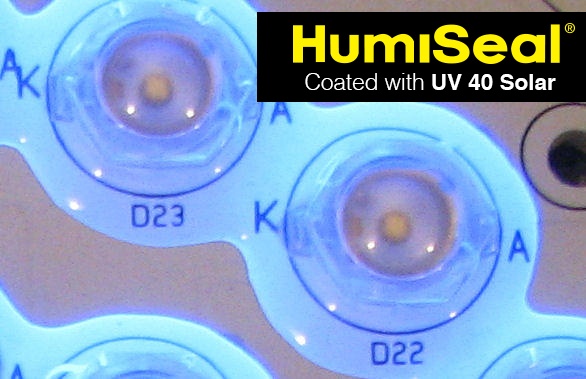Correct conformal coating can help keeping the lights on!
The use of LED’s is increasing rapidly. As a result of new legislation the use of LEDs (Light Emitting Diodes) will continue to replace incandescent bulbs in public.
One big difference with this new technology is that nearly all applications require drive/control circuitry, in the form of a printed circuit board, to control the functionality of these devices as the LED’s require low voltage Direct Current, as opposed to AC.
Most, if not all of these applications, will end up in exterior locations, where the units are likely to be exposed to a combination of temperature change, moisture (rain as well as humidity changes and condensation), corrosive gases, salt-spray etc.
For these exterior applications, the visual impression of the display is the key output, and importantly ensuring the output is consistent throughout the life of the product. A key requirement in ensuring consistent output throughout the lifetime, depends heavily on protecting the display and controls from the weather, without affecting the optical output.
When the lights go out…
LEDs generally fail due to ingress of corrosive gasses through the lens or failure in the thermal management on the back side of the LED.

Main environment threats to LEDs are generally:
- Automotive lighting and street lighting – where SO2 is present in the atmosphere. SO2penetrates the silicone lens and corrodes the LED chip causing failure.
- Visual displays – outdoor displays are exposed to high humidity and possibly SO2. The failure modes are again through the lens but also on the driver electronics.
Keeping the lights on….
The correct conformal coating can help
Probably one application proving the capability of conformal coatings is the protection of HD LED displays in swimming pools. High chlorine content atmosphere is very corrosive. The application of acrylic or UV coating designed for application over the LED provides long term protection and therefore long term reliability.
In addition to conformal coating, LED units can also be fully encapsulated in optically clear encapsulants. For both types of protection, it is key to use non-yellowing materials. Some materials discolor with time, temperature and exposure to sunlight.
Thermal issues – Removal of heat from high power LEDs is essential and this can be performed with thermally conductive encapsulants or thermal pads. LEDs running at the correct temperature will also be more reliable over time.
Properties Required For LED Conformal Coating and Encapsulation
FRONT SIDE (Lens):
- UV stable, QUV tested, no darkening over time.
- Thermal shock stability.
- Moisture and selective chemical protection.
- Low effect on light transmission.
- Lens compatibility, chemical & wetting.
- Good electrical properties.
- Thin and light.
- Encapsulation generally used when Ingress Protection (IP) is required.
BACK SIDE (chip lead fame):
- Thermally conductive for heat control.
- Thermal shock reliability.
- Protection from moisture and corrosive environments.
- Good electrical properties.

The use of the correct conformal coating and LED encapsulants will significantly improve LED reliability.
HumiSeal is a leading supplier of conformal coatings to the LED signage and display electronics, and has worked closely with most major LED manufacturers to ensure chemical compatibility. With the widest range of high performance conformal coatings, from every major type of protective chemistry (including Acrylic, Urethane and Silicone), you can be certain that HumiSeal has a high-performance solution for your specific application.
They have a wide range of environmentally compliant, low-outgassing, solvent-free materials, in addition to a wide range of traditional solvent-borne chemistries. Whatever your requirements, HumiSeal has the solution.
Partnertec has exclusive partnership with HumiSeal in the Benelux. If you would like to receive more information on their productline please do not hesitate to contact us.
Partnertec, your partner in best all-round solutions!




